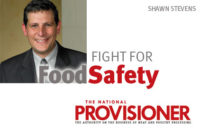Fight for Food Safety
Train your employees to think, not simply act

 The beef-processing industry faces incredible regulatory and litigation exposure as a result of food-safety and food-quality issues. These issues span from foodborne illness outbreaks, recalls and lawsuits to regulatory and litigation exposure from undeclared allergens and other quality issues.
The beef-processing industry faces incredible regulatory and litigation exposure as a result of food-safety and food-quality issues. These issues span from foodborne illness outbreaks, recalls and lawsuits to regulatory and litigation exposure from undeclared allergens and other quality issues.
With increased risk, processors need to rethink how they respond to that risk. Maintaining the status quo in this environment is not acceptable. Rather, companies should consider training risk management and mitigation to their employees.
Effective risk management and mitigation reduces exposure. This, however, requires companies to do far more than offer the food-safety training currently provided by most food processors. Many companies currently use training programs requiring only that an employee read a small pamphlet (or watch a short video) on the most basic of food-safety topics, and then answer only a few true-or-false questions on a single sheet of paper. Under these programs, a score of 70% typically indicates a “pass.”
Guess what: Under these programs, employees are not being taught to think.
Of course employees will acknowledge that they must wash their hands after using the bathroom, and they will always wear a hairnet. But, what’s missing is a strategy that teaches employees how to find, identify and then mitigate risk. Or, put another way, to look for problems, and then to solve them. If employees are never trained to proactively identify risk, the chance of finding a problem before it leads to a food safety or quality failure is decreased dramatically.
So, food processors should train their employees to think — and think differently.
Employees should be challenged with mock scenarios that require them to identify existing food-safety or food-quality risks within the facility, and then develop mitigation strategies that will eliminate those risks. Such exercises can be easily taught to a group of employees by existing food-safety managers.
If done with the proper structure and frequency, you can influence the way employees think. As your employees’ thinking changes, proactive risk assessment and mitigation will start to become habit.
If this habit develops, most of the hidden risks causing the vast majority of outbreaks and recalls can be found and eliminated long before a food safety or quality disaster occurs.
Looking for a reprint of this article?
From high-res PDFs to custom plaques, order your copy today!




